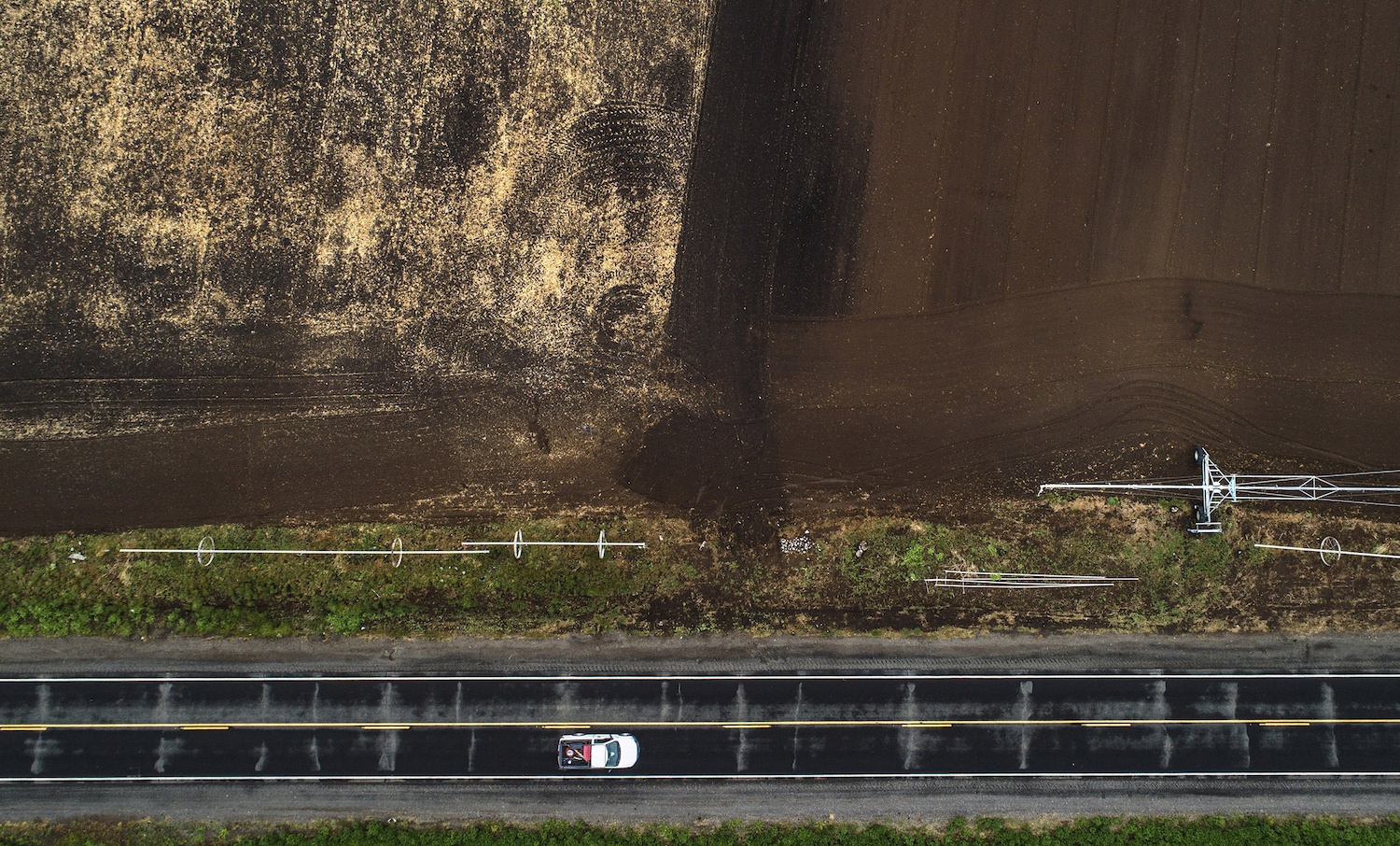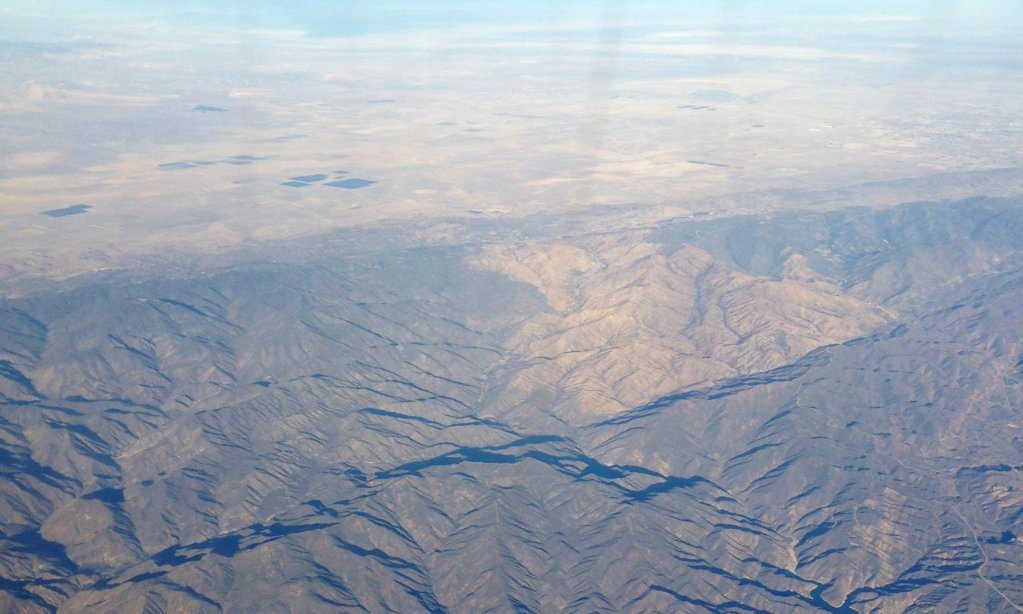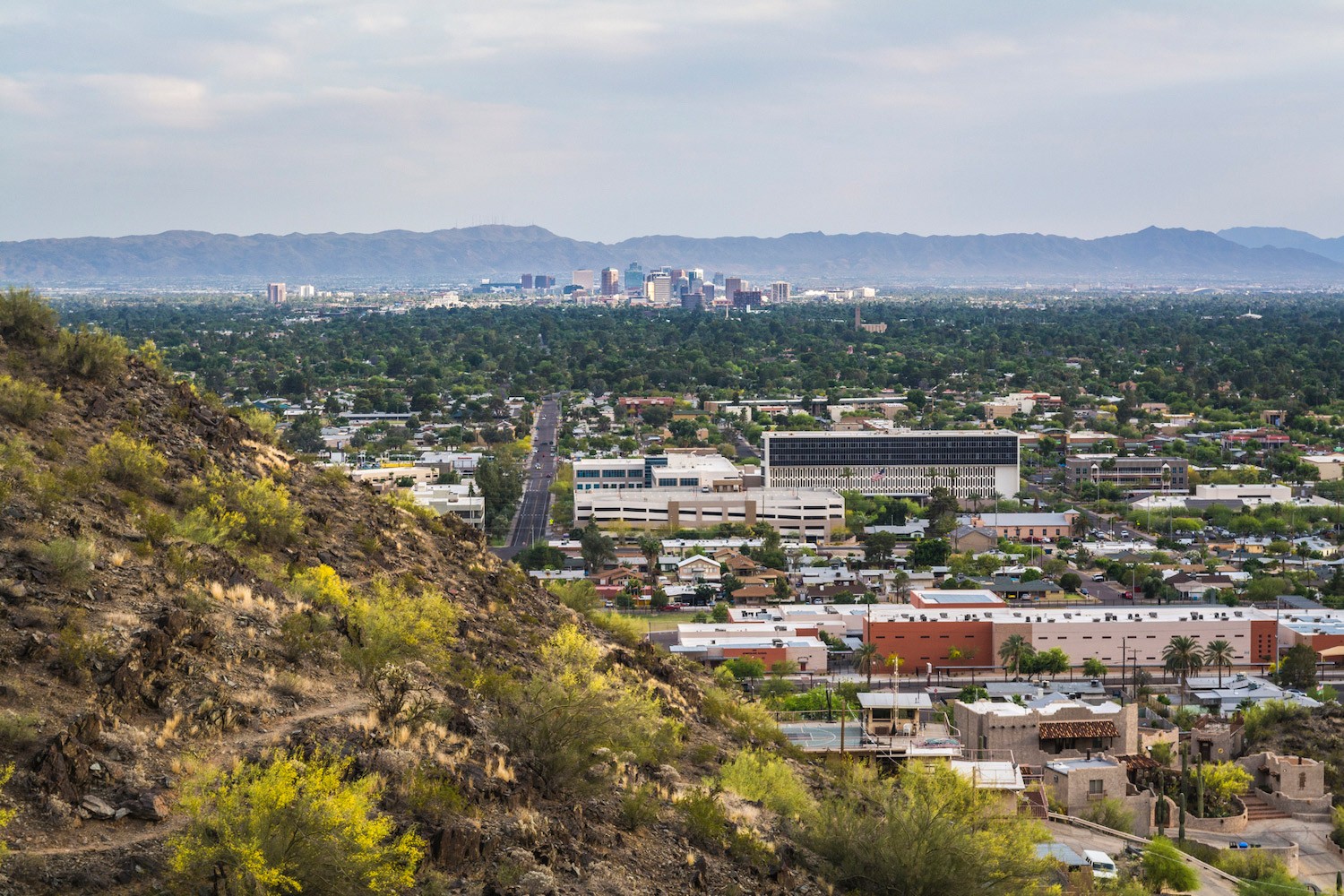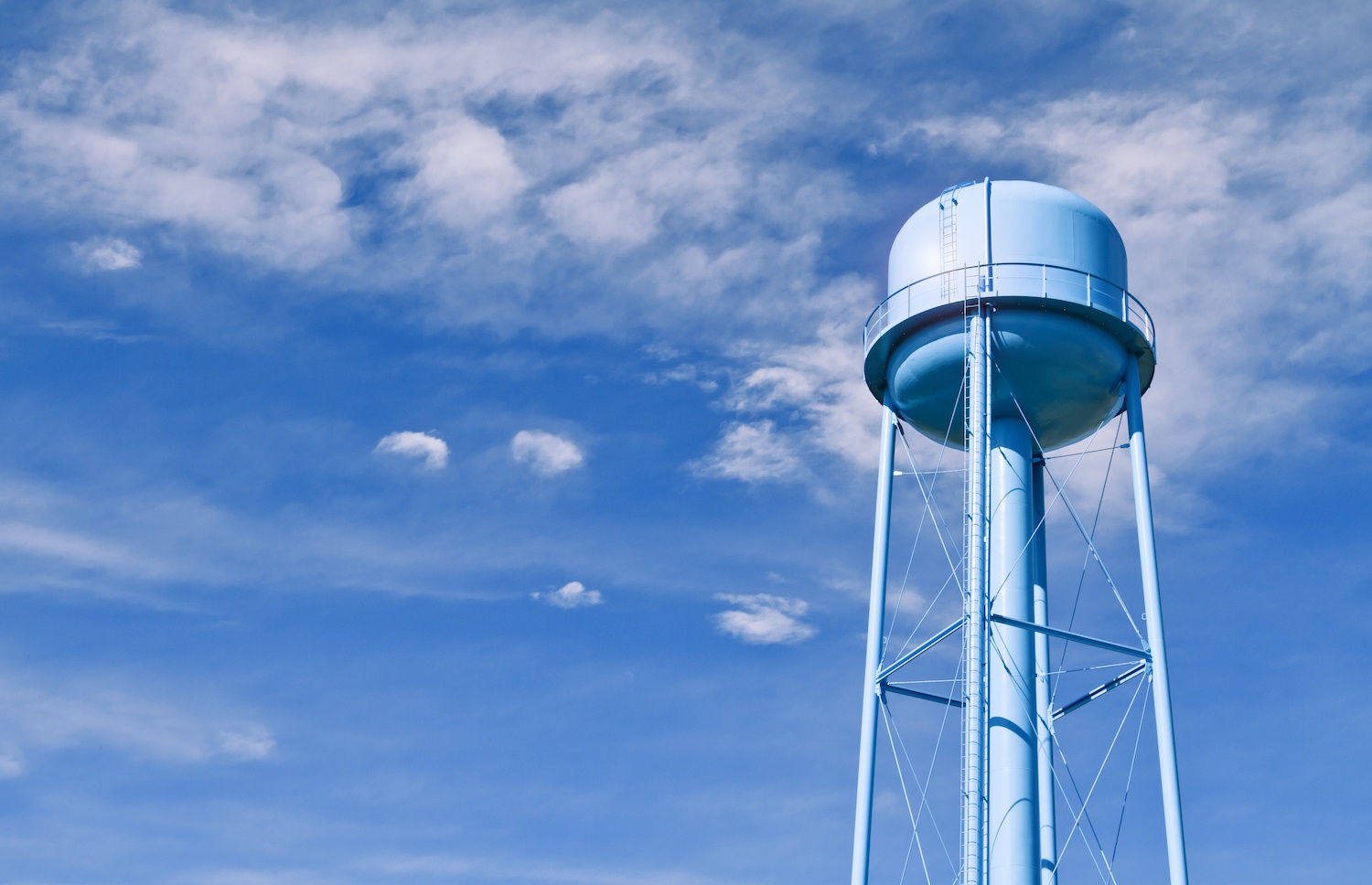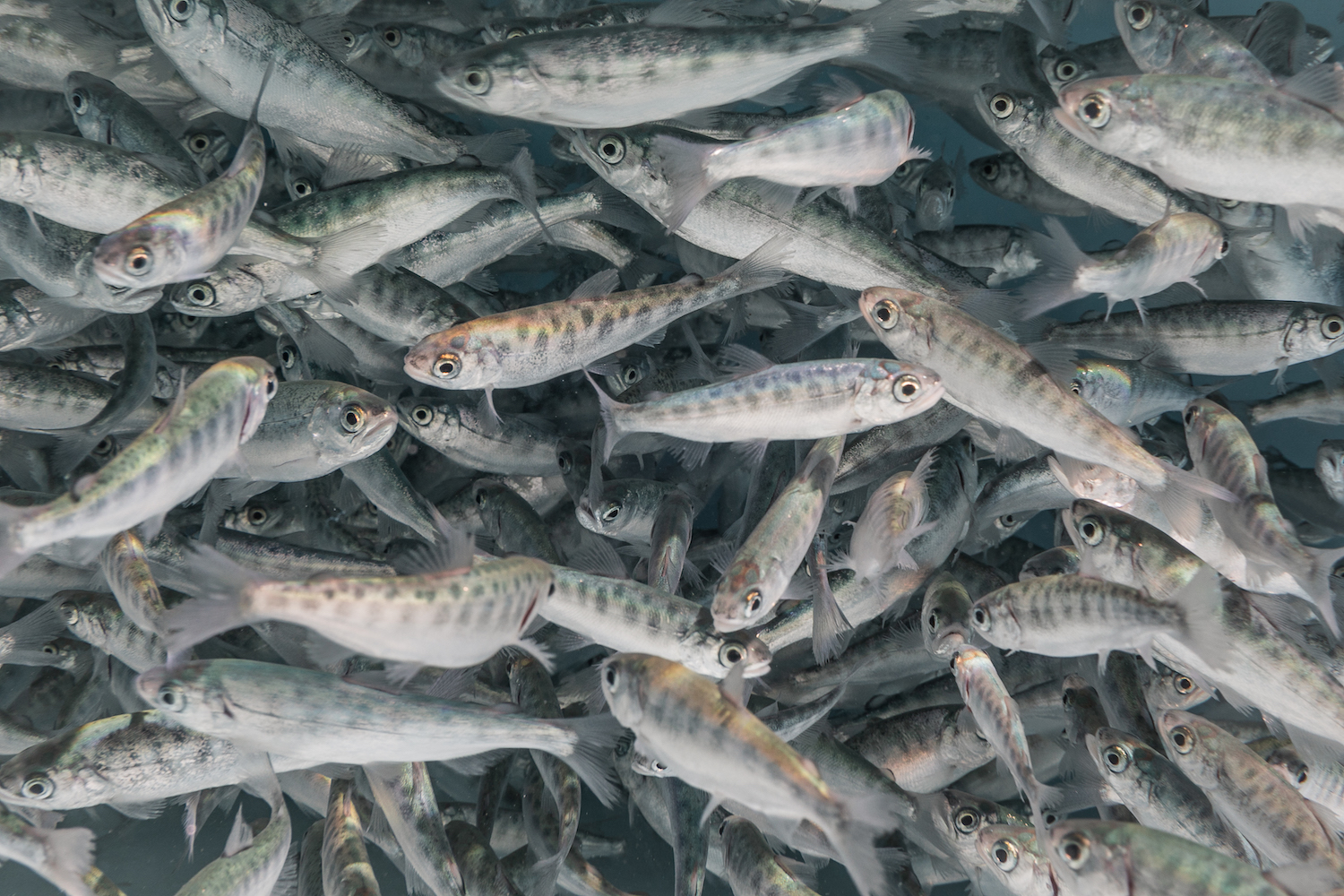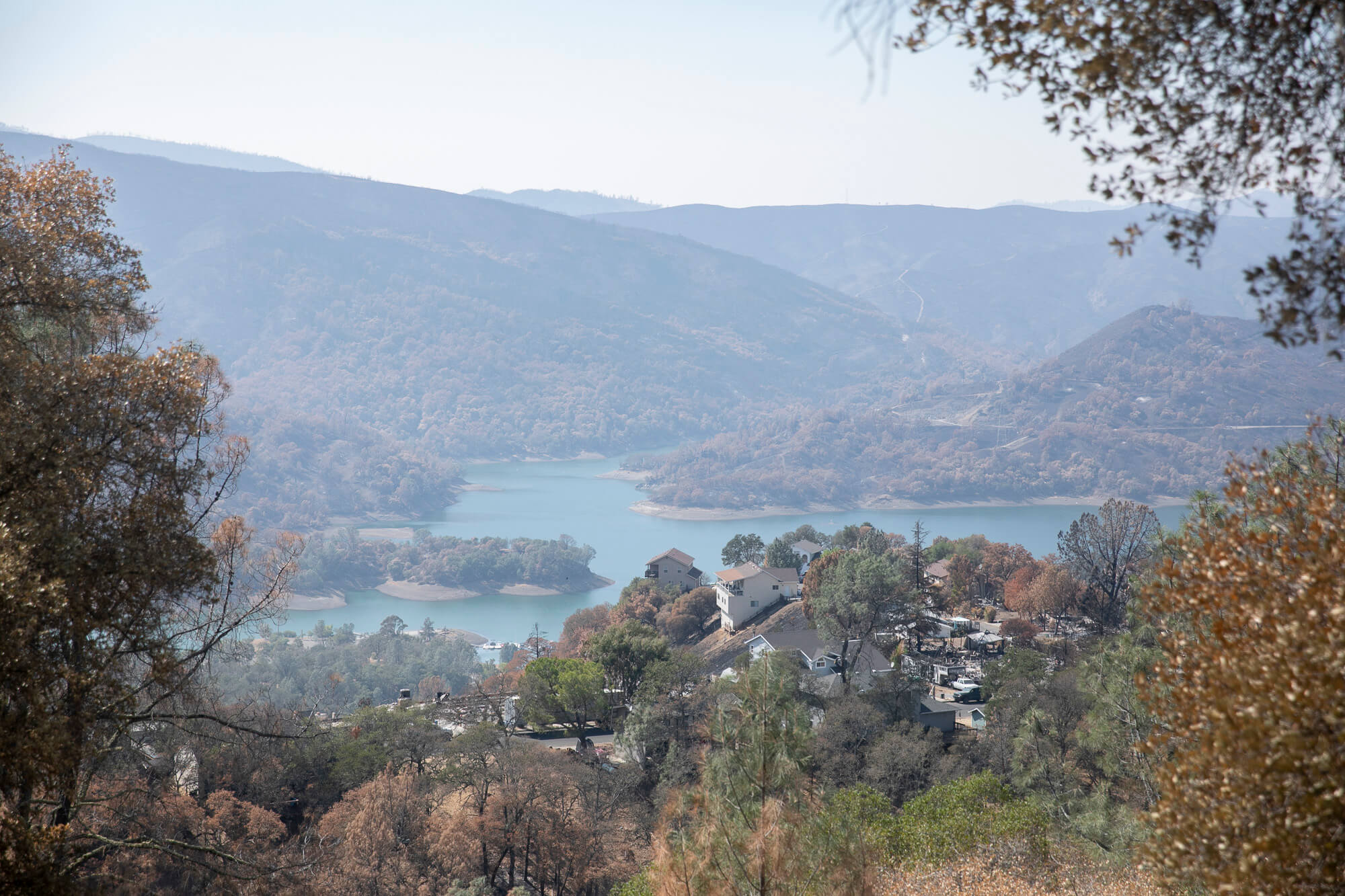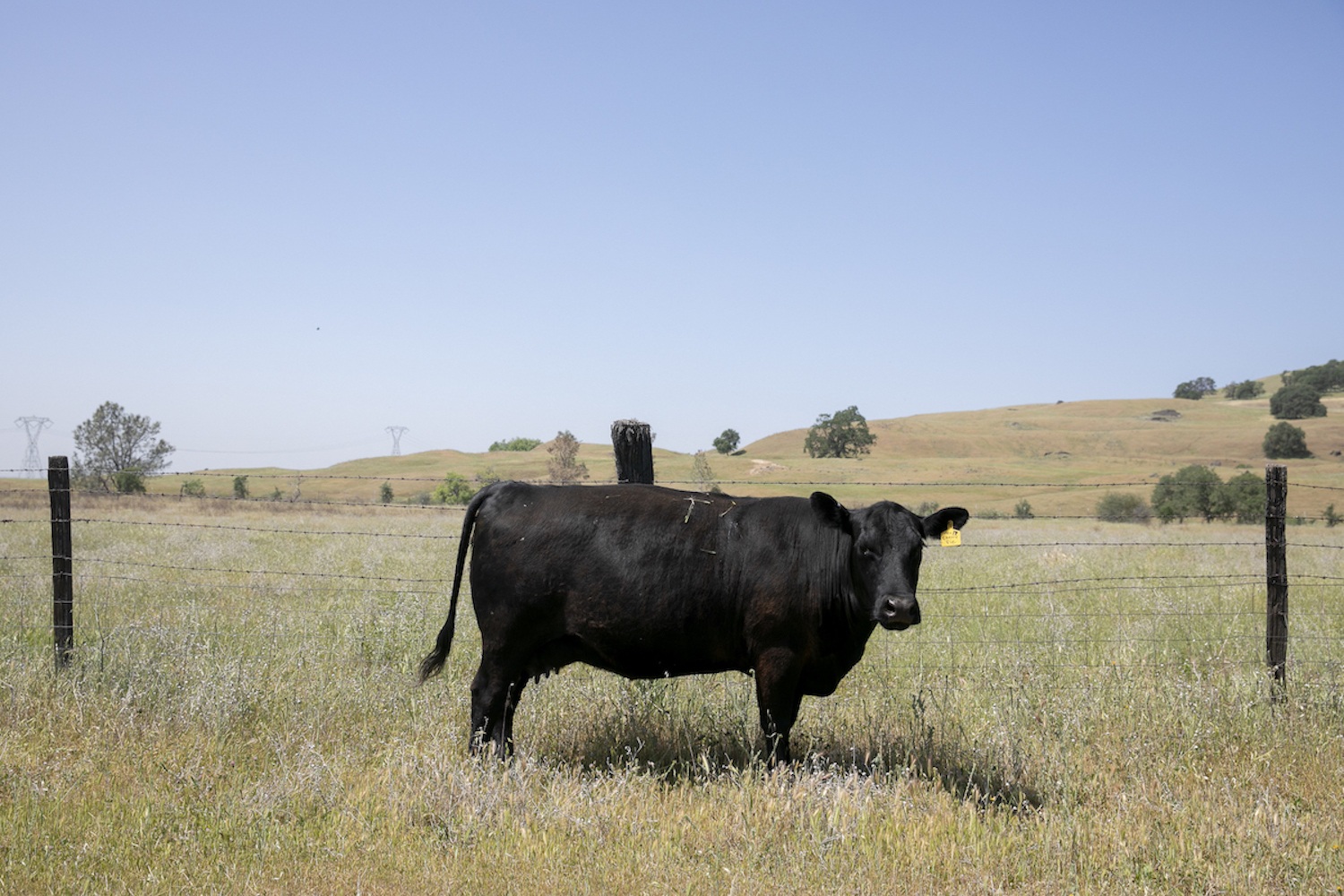
Photo by Anne Wernikoff, CalMatters
With most of the state gripped by extreme dryness, CalMatters digs into which conditions are better—and which are worse—than the last record-breaking drought.
When James Brumder and his wife Louise Gonzalez moved into their home tucked up against the mountains northeast of Los Angeles, he applied all his know-how to the task of undoing the thirsty garden they inherited.
This story originally appeared in CalMatters, an independent public interest journalism venture covering California state politics and government.
Brumder, who worked for a commercial landscaping company, pulled up their weedy, unkempt lawn in Altadena and replaced it with native grasses, filled in garden beds with species that could make a living off the region’s fickle rainfall, installed drip irrigation, set up rain barrels and banked soil to collect any errant drops of water. Whenever the backyard duck pond — a blue plastic kiddie pool — was cleaned, the water was fed to drought-adapted fruit trees.
It was 2013, a year before a statewide drought emergency was declared, but even then the water crisis was apparent to Brumder and most everyone in California: A great dry cycle had come again. Four years later, it receded when a torrent of winter rains came. The drought, finally, was declared over.
Generals know that you always fight the last war. So California — already in the clutches of another drought emergency — is looking over its shoulder at what happened last time, anticipating the worst and evaluating the strategies that worked and those that failed.
So is California in a better position to weather this drought?Some things are worse, some better: Groundwater is still being pumped with no statewide limits, siphoning up drinking water that rural communities rely on. In northern counties, residents are reliving the last disaster as water restrictions kick in again, but in the south, enough water is stored to avoid them for now.
The good news is that in urban areas, most Californians haven’t lapsed back into their old water-wasting patterns. But, while some farmers have adopted water-saving technology, others are drilling deeper wells to suck out more water to plant new orchards.
The upshot is California isn’t ready — again.
“We are in worse shape than we were before the last drought, and we are going to be in even worse shape after this one,” said Jay Lund, co-director of the Center for Watershed Sciences at University of California at Davis.
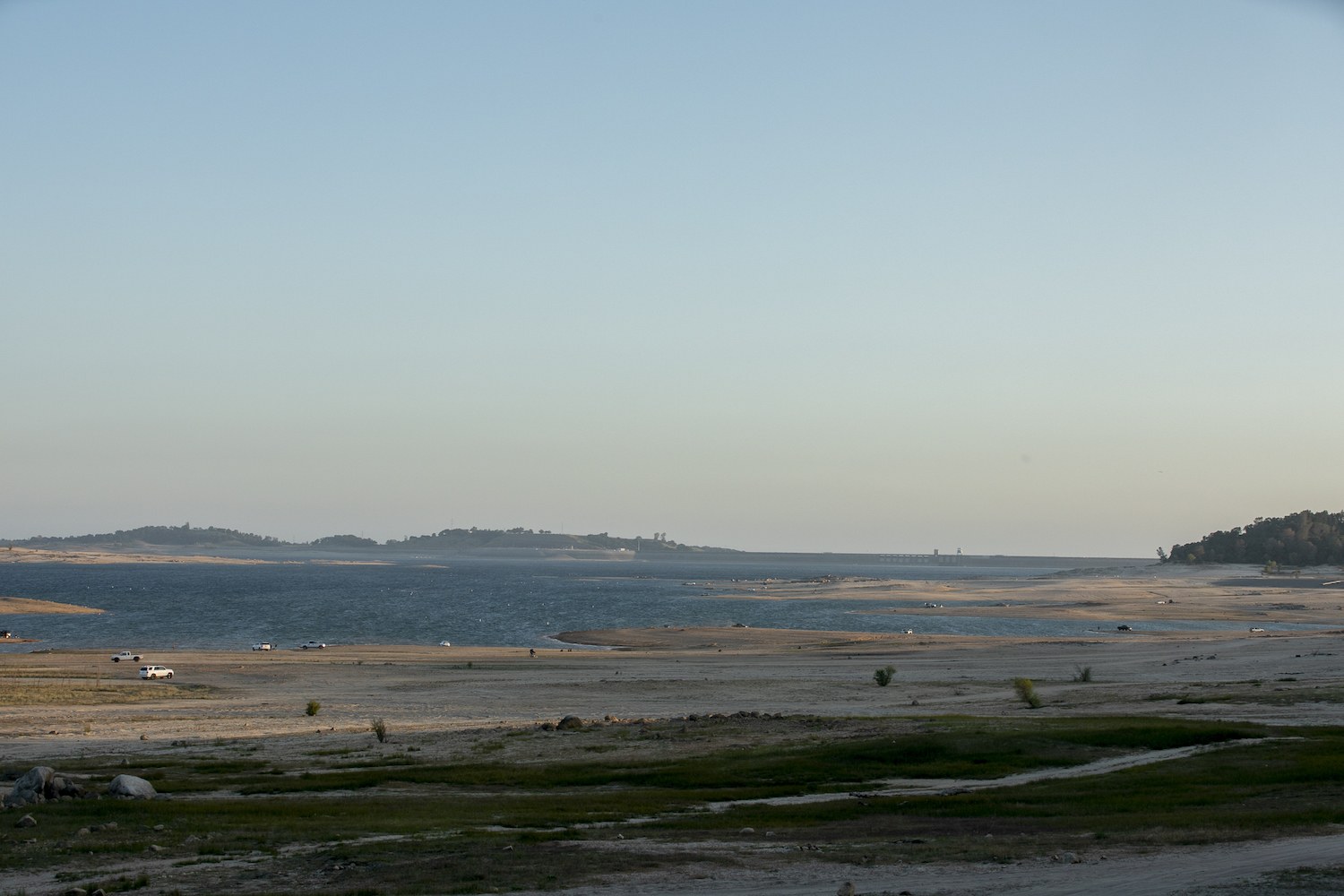
Trucks are parked along the waters edge in the dry lakebed at Lake Folsom, a state reservoir. The water level is currently at about 48% of historical average.
Anne Wernikoff, CalMatters
The most acute problem, experts say, is the lack of controls on groundwater pumping.
“Despite increasingly occurring droughts, we could be doing much better than we are doing,” added Peter Gleick, co-founder of the Pacific Institute, a global water think tank. “We manage finally to get some statewide rules about groundwater, but they are not going to be implemented for years.” As a result, he said, aquifers are still being over-pumped and land is sinking.
And an overarching question lingers: How will Californians cope as the world continues to warm and the dry spells become ever more common and more severe?
Then and now: How does it compare?
Three-fourths of California is already experiencing extreme drought, a designation that only hints at the trickle down of impacts on people, the environment and the economy. Nature’s orderly seasons are upended: As the winter so-called “wet season” ended, Gov. Gavin Newsom declared a drought emergency in 41 counties.
This year’s drought is steadily approaching the peak severity of the last one, climate experts say. It’s a dangerous benchmark: 2012 through 2015 was the state’s driest consecutive four-year stretch since record-keeping began in 1896.
Drought is characterized by deficit — of rainfall, snow, runoff into rivers, storage in reservoirs and more. And all of these factors are in dire shape this year. Some are even worse than they were during the last drought.
Much of the state has received less than half of average rain and snowfall since October, with some areas seeing as little as a quarter. For most of Northern California, the past two years have been the second driest on record.
The Sierra Nevada snowpack, which provides about a third of California’s water, dwindled to 5% of average this month, equaling April 2015’s record-low percentage. That signals trouble for California’s reservoirs — even before the long, dry summer begins.
Already, the water stored in major reservoirs is far below normal as some rivers’ runoff has dipped below the last drought’s levels. Lake Oroville, which stores water delivered as far away as San Diego, has dropped to just under half of its historic average for this time of year.
“We’ve had dry springs before, but that is just astonishing,” said Daniel Swain, a climate scientist at the University of California, Los Angeles and The Nature Conservancy. “And we’re still a few months out from seeing the worst of things.”
Megan Brown, a sixth-generation cattle rancher in Oroville, worries that climate change might finally make her the last of her family to run cattle in California. Dry pastures can force ranchers to sell livestock or buy expensive feed.
Usually, she said, the hills on her ranch are as green as Ireland in the spring. But by the end of April, dry golden grass had already started to claim the slopes. The blackberry-lined creek on Brown’s ranch is so parched that her dogs kick up clouds of dust as they nose through the rocks.
“It’s turning,” she said, looking up at her browning hills dotted with so many fewer cows than usual. “I don’t like it. It’s scary.”
Prolonged dry periods, some more than a hundred years in the state, can be traced to the Middle Ages, via tree rings from stumps preserved in lakes. But while droughts are part of California’s natural cycles, climate change is exacerbating them, increasing drought frequency and making them more extreme, climate experts say.
In his 1952 novel, East of Eden, John Steinbeck depicted the yin and yang of California’s water cycle in the Salinas Valley where he grew up, how the bounty of the wet years drove out memories of the dry, until, predictably, the water wheel came back around. “And it never failed that during the dry years the people forgot about the rich years, and during the wet years they lost all memory of the dry years. It was always that way.”
But droughts and water shortages are more of a persistent way of life now in California than a mere cycle. The rare has become the routine.
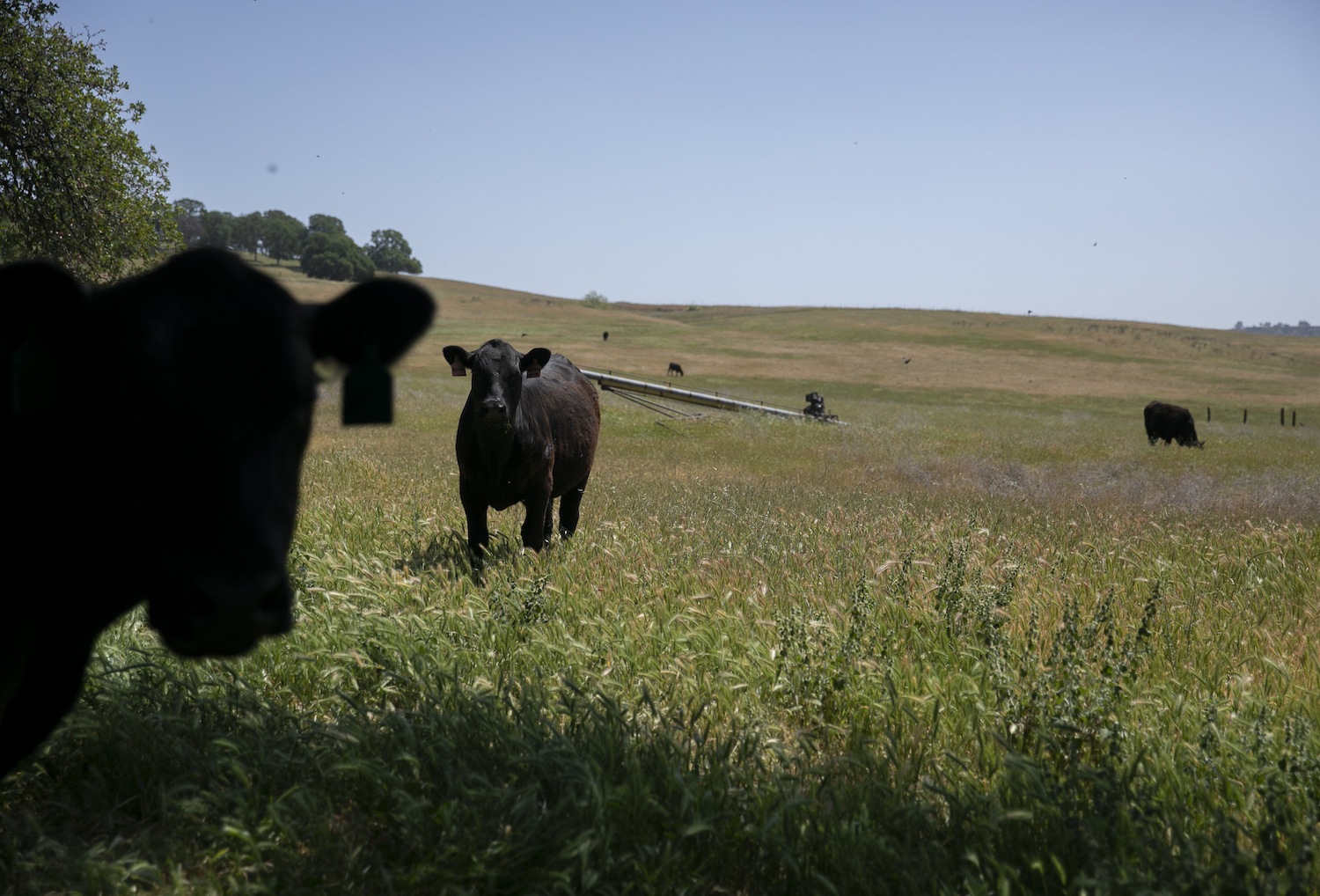
Prematurely yellowing pastures speckled with the remaining cows on Megan Brown’s ranch in Oroville on April 22, 2021. Brown sold off much of her herd earlier this year after realizing she wouldn’t have enough grass to feed them.
Anne Wernikoff, CalMatters
Drought’s terrible price
The last drought posed a palpable, day-to-day crisis. The signs were clearly visible: withered crops and gardens, bathtub rings around shrinking reservoirs, dried-out salmon streams. People drove filthy cars and thought twice about flushing their toilets. Ski runs reverted to gravel and mountain resorts shut down months early.
All Californians were ordered to conserve, and state officials in 2015 mandated a 25% statewide cut in the water used by urban residents. Homeowners used smartphone apps to turn in neighbors for over-sprinkling their lawns, and cities hired water cops to enforce the rules. Hotels notified guests of reduced laundry service. In restaurants, glasses of water that used to automatically appear were served only after patrons requested them.
Thousands of rural wells, particularly in the Central Valley, ran dry, forcing the state to truck in emergency drinking water to hard-hit Latino communities. In 2014, with years of the drought to go, recent groundwater levels in some parts of the San Joaquin valley had already sunk 100 feet — the equivalent of a 10-story building — below historic norms.
Agriculture took a $3.8 billion hit from 2014 through 2016. More than a half-million acres of farmland was taken out of production for lack of irrigation water, and an estimated 21,000 jobs were lost in 2015 alone.
The astonishing aridity also killed more than 100 million trees and weakened millions more, setting off a catastrophic cascade: The carpet of dead trees added fuel to California’s wildfire epidemic. Fire season stretched year-round and into normally damp parts of the state.

A decal on the dusty tail gate of a Orange County Water District truck asks people to conserve water near their recharge facility on Wednesday, May 6, 2015 in Anaheim, Calif. The State Water Resources Control Board approved new restrictions Tuesday that include a mandatory target for each local water agency to reduce consumption.
AP Photo/Chris Carlson
As rivers heated up, their flows dwindled and about 95% of endangered winter-run Chinook salmon were lost below Shasta Dam in two consecutive years. A record number of commercial and recreational fisheries were shut down, and countless ducks and other waterbirds died as wetlands vanished.
“California was unprepared for this environmental drought emergency and is now struggling to implement stopgap measures,” the Public Policy Institute of California concluded in 2015.
Today, despite the warnings, in many ways the state finds itself in the same situation: Forewarned but still not ready.
“The universal truism is that by the time you react to a drought it’s too late to react to a drought,” said Jeffrey Mount, a senior fellow at the Public Policy Institute. “The majority of things you have to do to mitigate impacts have to be done before the drought.”
Droughts are expensive for taxpayers. The legislature appropriated $3.3 billion toward drought response from 2013 to 2017, including $2.3 billion in voter-approved bonds. About $68 million was spent on emergency drinking water for communities where wells went dry, but the biggest chunk funded projects to begin augmenting supply, such as more water recycling and groundwater management.
Now, to address the current drought, the Newsom administration has proposed spending another $5.1 billion, for a start. But the “start” may be already too late.
“I can think of a lot of places to spend money, “ Mount said. “But it’s too late for this drought.”
Natural Resources Secretary Wade Crowfoot said California is better prepared than before the last drought, but climate change is quickly moving the finish line.
“We are in a race against time and the changing climate. And so all that we’ve done is important, but we need to do more,” Crowfoot said.
Felicia Marcus, the top water official who shepherded the state’s response to the record-breaking drought under former Gov. Jerry Brown, said California “made real progress in some areas during the last drought” but needs to conserve and recycle more water, capture more in aquifers and better protect ecosystems.
Learning to live with less
The experience of the last drought left behind lasting effects across California, in the way that trauma can afford painful lessons.
But it’s one thing to repeat the mantra that “water is precious” and quite another to learn to live with less of it. State officials are relieved that some behaviors mandated in the last drought have become habits with lasting benefits for conservation.
Between 2013 and 2016, Californians on average reduced their residential use by 30%. Since then, per capita water use has ticked up, but Californians used 16% less water in recent months than they did in 2013.
The ubiquity of drought has forced many Californians to change their fundamental relationship with water.
Their responses to the pleas to conserve have varied, reflecting the state’s diversity of climates, populations, property sizes and lifestyles. For instance, urban residents of the San Francisco Bay Area, the Central Coast and North Coast used the least amount of water in 2020 — an average of 71 to 73 gallons a day per person — compared to 86 in Southern California, 125 in the Sacramento Valley and 136 in the southern San Joaquin Valley. Every region’s use edged up slightly last year — perhaps due to COVID-19 sheltering at home — but every region is considerably lower than the early years of the last drought.
Some Southern Californians endorsed conservation with a vengeance, ripping out more than 160 million square feet of lawnsduring the last drought. Golf courses followed suit; they tore out turf on non-playing areas in favor of drought-tolerant plants, while watering greens and fairways with recycled water.
Still, households using 400 gallons per day aren’t uncommon in Southern California, said Los Angeles County Public Works Director Mark Pestrella. And, despite permanent conservation gains leftover from the last drought, some massive residential water users — called water buffalos — use 4,000 gallons a day.
The disconnect? “Water is cheap,” Pestrella said.
Despite permanent conservation gains leftover from the last drought, some massive residential water users — called water buffalos — use 4,000 gallons a day.
The state’s cobbled-together policies of carrots and sticks managed to reduce water consumption in cities statewide. California officials toughened standards for toilets, faucets and shower heads and ramped up efficiency requirements for new landscaping. Millions of dollars in rebates were offered by state and local water agencies to coax Californians into replacing thirsty lawns.
When conservation alone wasn’t enough, an executive order by then-Gov. Brown gave officials the authority to send help to well owners and struggling small water systems.
Some policies, however, have not yet been fully realized.
Lawmakers tasked state agencies with developing efficiency standards for residential, commercial, industrial and institutional water use, but these are still in the works. Also, statewide rules that banned wasteful practices like hosing off driveways expired in 2017. The water board’s 2018 effort to revive them was dropped after local agencies complained that mandates should be left up to them.
A major law enacted during the last drought is supposed to stop groundwater depletion over the next 20 years. But the law is still in its very early stages; the state has not limited groundwater pumping anywhere yet.
“We do an absolutely terrible job at some things, and groundwater is one,” said UC Davis’s Lund. “It takes 30 years to implement (the new groundwater act) from zero to something sustainable. It’s going to take a long time and it’s going to be ragged around the edges.”
Lawmakers were warned by state analysts last week to prepare for wells to go dry again, largely in Central Valley rural towns, and line up emergency supplies of drinking water.
“I suspect we’re going to see similar issues with wells running dry and damage to infrastructure that we saw during the last drought,” said Heather Cooley, director of research at the Oakland-based Pacific Institute. “We’re going to see a lot of that this year and in the coming years.”
The mighty agriculture industry, which uses the bulk of California’s water, plowed up some crops such as rice and alfalfa to save water. A state program awarded growers more than $80 million in grants to install low-pressure irrigation systems and make other conservation measures.
But growers also continued to plant new fruit and nut crops, despite the recurring water shortages. Some farmers offset their financial losses by fallowing fields and selling their water to other growers.
Some orchard growers intensified groundwater pumping by digging deeper wells and using “new water” to plant more trees. The number of acres of almond trees — a water-intensive, high-value crop — doubled in the last decade, although the industry has significantly improved its water efficiency in recent years. “High returns on orchard crops have made it profitable for farmers to invest in deeper wells, aggravating groundwater depletion,” according to a Public Policy Institute of California analysis.
Ranchers face difficult decisions
Katie Roberti of the California Cattlemen’s Association told CalMatters that ranchers are facing the most severe conditions in decades. “Without precipitation many California cattle producers are going to be forced to make the difficult decision to reduce the size of their herds, some more drastically than others,” she said.
Megan Brown, the Oroville rancher, already sold a third of her cattle — including all of her replacement breeders that replenish her herd — after the dry 2020 winter, when the grasslands they forage on dried up.
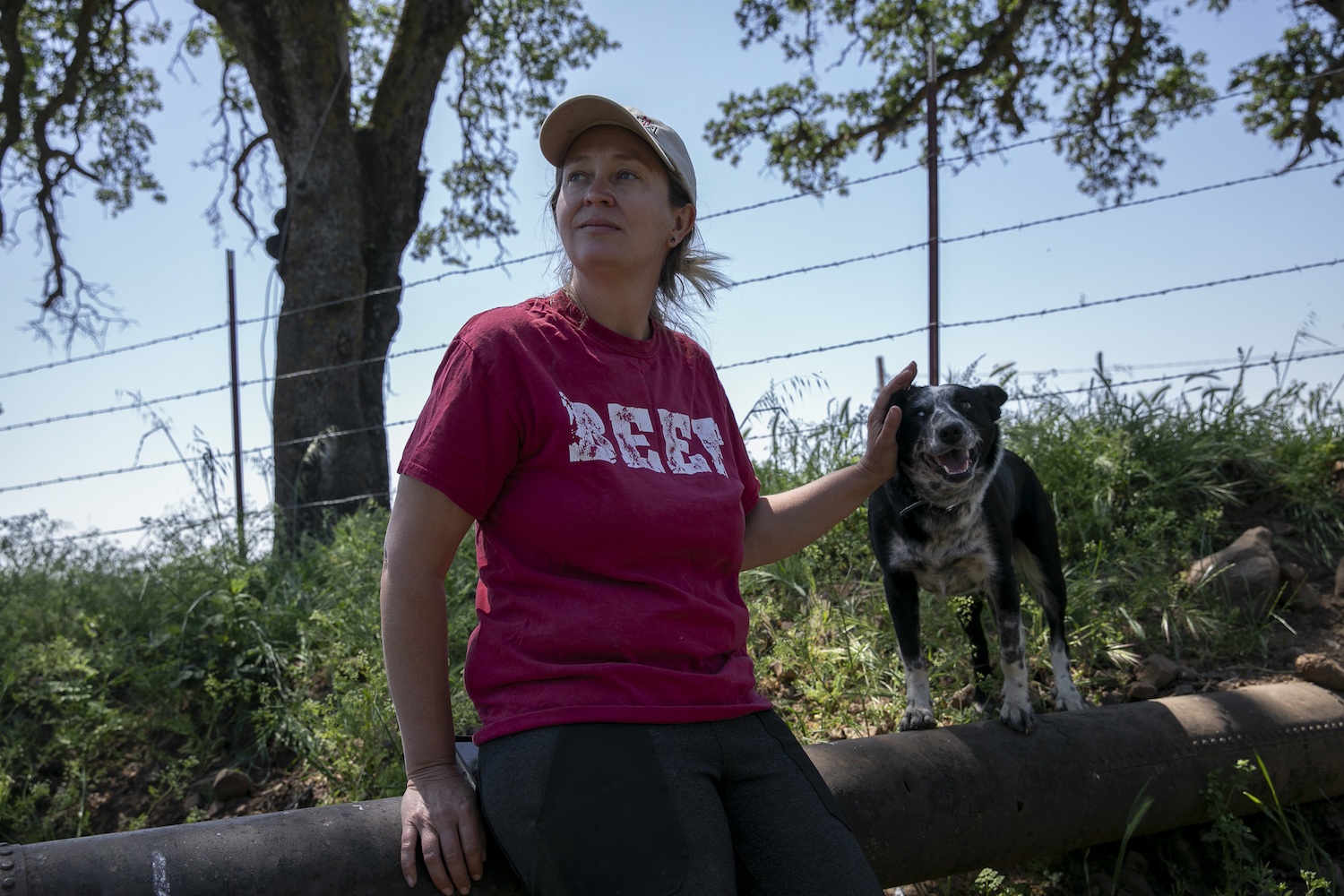
Rancher Megan Brown sits with one of her dogs in the dry creek on her property on April 22, 2021.
Anne Wernikoff, CalMatters
“We were ahead of the game because we saw the writing on the wall,” she said. “If you don’t have the grass, you’re not going to make the money.”
She sold “anything that looked at me funny, or had an attitude, or I thought would fail or wouldn’t make me money,” she said. “It was hard, some of these cows I’ve had for ten years.”
The US Department of Agriculture declared a drought disaster that allows growers and ranchers to seek low-interest loans.
But Brown refuses to accept a loan. “Our family history has a saying that if you can’t buy it in cash, you can’t really afford it.”
Brown has seen back-to-back calamities hit her land: drought, torrential rains and then fires that destroyed wooden flumes that ferry water from the west branch of the Feather River to Oroville and landowners like her along the way.
“It’s all these things, bam, bam, bam, bam, bam — every year. It’s not supposed to be like that. We’re supposed to have these once in a generation,” Brown said. “It’s more. It’s worse.”
She’s already weighing how to adapt her ranch to a changing California, such as raising heritage hogs and turkeys instead of cattle, and wondering whether there’s a future in emus.
“It hurts, man, it hurts your soul,” Brown said. “I always felt like I might be the last one in the family to run cattle. I’ve just had a bad feeling. And this kind of makes it real, like my bad feeling was justified.”
North and south: One dries up while one stored for a rainy day
When you take into account the path that water moves from source to tap, it’s a daily miracle that any of it arrives at its destination. Every day 20% of the electricity used in California and 30% of the natural gas is used to pump water.
All that energy is necessitated by geography: Much of the state’s water is in the north and much of its population is in the south. This shift requires the State Water Project’s massive pumping plants to push water uphill 2,000 feet from the floor of the San Joaquin Valley and over the Tehachapi Mountains, where it flows down to the great southern basin and its 24 million people.
This year, the state expects to deliver only 5% of water requested from the State Water Project. And there’s an indefinite hold on federal allocations for some agricultural users both north and south of the Delta.
Nevertheless, the Metropolitan Water District, which supplies imported water for 19 million people in six Southern California counties, says it has managed to sock away record levels of water despite back-to-back dry years.
“We’ve gone into this year with the highest storage levels in our history, actually,” said Deven Upadhyay, assistant general manager and chief operating officer for the Metropolitan Water District. “Storage-wise, we go into this year — the second year of a drought, and now a really critical year — pretty well positioned.”
About 3.2 million acre-feet of water are tucked away in storage, with another 750,000 reserved in case of a disaster like an earthquake. That’s enough to meet the demands of 12 million households in the Los Angeles area.
As a result, Southern California agencies are unlikely to mandate rationing this year, although Upadhyay encourages residents to be careful with their water use.
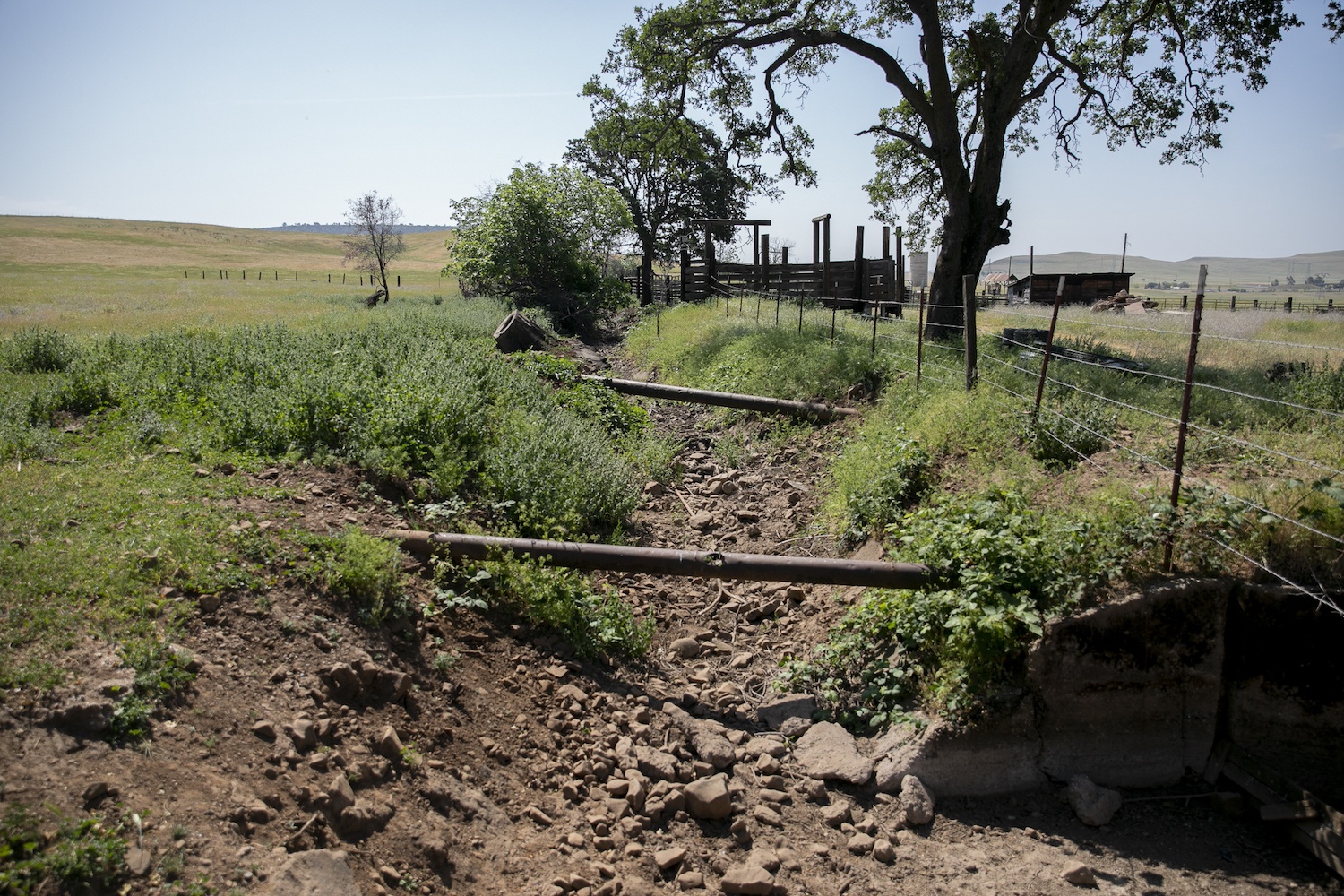
A creek that once ran through Megan Brown’s property is already dry before the summer comes on April 22, 2021.
Anne Wernikoff, CalMatters
But in the north, the situation is more dire. Some local agencies and counties are already limiting water use long before the drier summer months arrive.
For some, it’s deja vu: Fountains are going still again, pools and hot tubs must be covered and residents are urged to turn down taps and swap out lawns. Some water providers are already hiking rates to pay for emergency water supplies.
The town of Mendocino, which depends heavily on rain-fed aquifers, declared a stage 4 water shortage emergency requiring residents to use 40% less water than allotted. Many residents are already there, said community service district superintendent Ryan Rhoades.
In Redwood Valley, which has roughly 1,100 municipal and 200 agricultural customers just north of Ukiah, the water district has already turned off the tap to agricultural customers.
Bree Klotter, a wine grape grower and member of the district’s board, said it’s one more challenge for residents who are just emerging from devastating wildfires on the heels of the last drought.
The district earlier this month set a 55-gallon-per-person-per-day limit on residential water use, and expected pushback. But it never came.
“We had set a meeting for two hours and literally nobody showed up,” Klotter said. “I don’t know whether it’s because they have adapted their behaviors to accommodate the drought, or whether they’re just like, this is just something else — one more thing.”
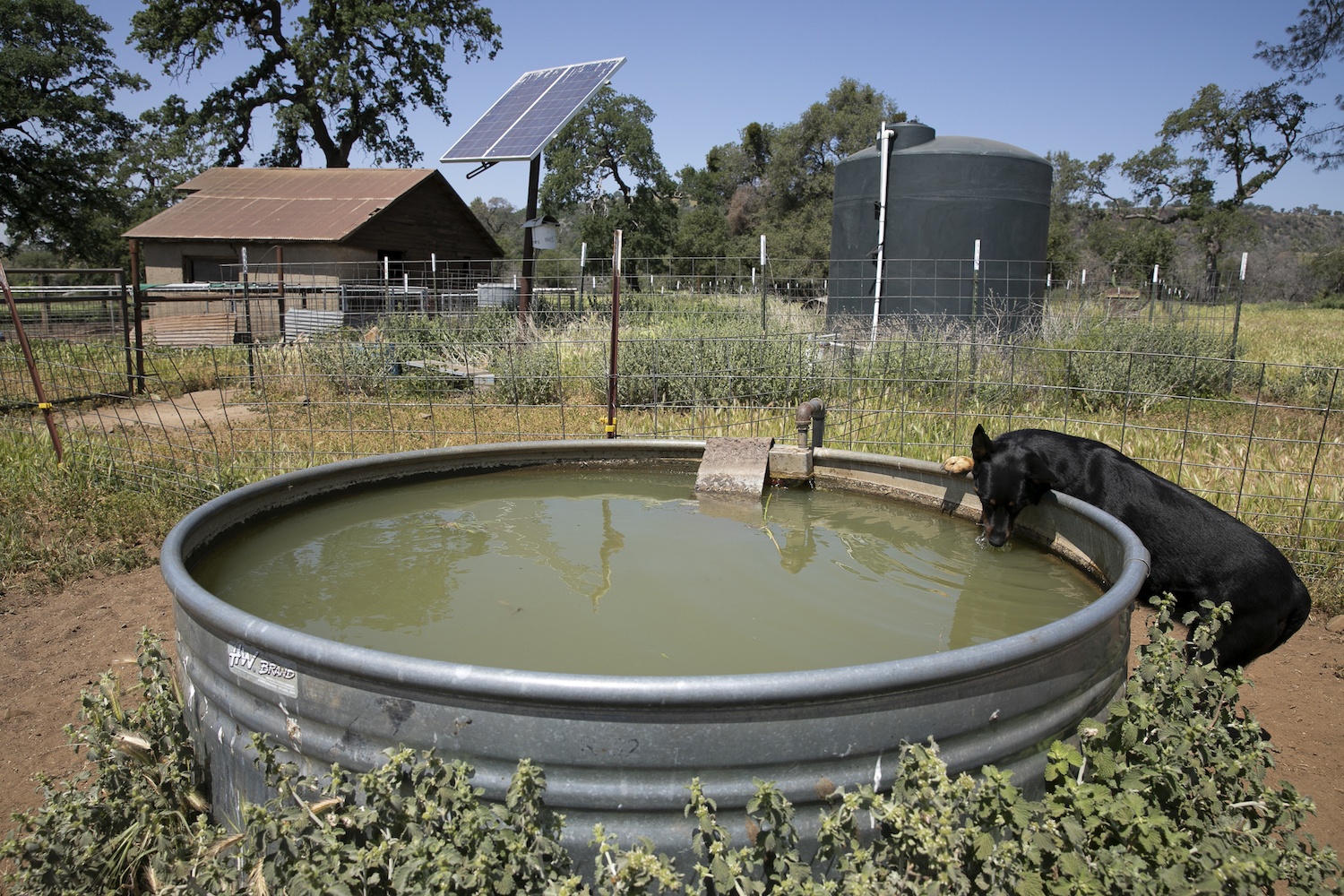
A ranch dog drinks from the well with a solar panel and water storage tank seen in the background. Brown has attempted to make her ranch as sustainable is possible.
Anne Wernikoff, CalMatters
Her well is ‘more valuable than gold’
Novelist Joan Didion wrote that growing up in Sacramento, she knew it was summer when “coughing in the pipes meant the well was dry.”
It’s a sound familiar to many, and a harbinger of dry times. About 60% of California’s water supply comes from groundwater during dry years, and the state has roughly a million residential wells. More than 2,000 households reported dry wells during and after the last drought.
Some well owners are already struggling with coughing pipes this year.
Jasna Hendershott, 66, has lived in the same house in the mountain town of Oakhurst outside of Yosemite National Park for nearly three decades. She has always been careful how she uses her well water.
During hot summers, Hendershott uses paper plates to avoid washing dishes. She takes short showers, only washes full loads of laundry and she doesn’t have sprinklers for her yard.
“It’s more valuable than gold, and you really need to worry about it,” Hendershott said. “If you don’t save water, then you’re putting everybody into danger.”
Even so, during the last drought, her well occasionally ran dry during summer months. And about a year-and-a-half ago, it dried up completely. While she waits to find out whether she needs to drill a deeper well, Hendershott has been relying on water deliveries to fill her well’s storage tank — first from Madera County and now from the non-profit Self-Help Enterprises.
She isn’t the only one; the non-profit coordinates water deliveries for more than 320 other households.
Monthly water deliveries can run the nonprofit $1,500 a month for a household, on top of about $5,000 to buy and install a storage tank — totaling close to $23,000 for the first year. The money comes from state grants.
During the last drought, California spent roughly half a million dollars a month to dispatch water to those without.
Of all the lessons the state should learn, this might be the most valuable: “There’s never enough water in California,” the Pacific Institute’s Gleick said. “We have to assume that we are always water-short and we have to act like it.”


